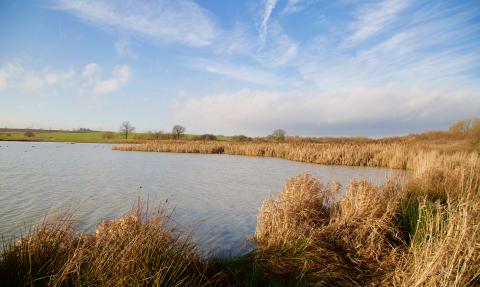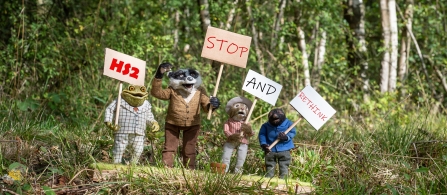
Carr Vale nature reserve, Guy Badham
Stop. Rethink HS2.
HS2 is coming to Derbyshire
The Government's chosen route for HS2 will create widespread destruction and fragmentation of large areas of natural habitat and important protected wildlife sites. It is set to cut through over 25 miles of Derbyshire. Over 5,000 acres of land is likely to be affected. With water voles, skylarks and swifts being just a few of the species at risk.
In the most comprehensive environmental assessment to date we can reveal the sheer scale of potential damage from HS2. The Wildlife Trusts report shows that the deep cut HS2 will make across the landscape could stop nature’s recovery in its tracks. As the costs to nature escalates, we’re urging the Prime Minister Boris Johnson to use his power now to stop and rethink this project, or the scar may never heal. Join us and sign our letter to the Prime Minister now!

How will this effect Derbyshire?
The proposed HS2 railway line is set to cut through over 25 miles of Erewash, Bolsover, North East Derbyshire and Chesterfield. Over 5,000 acres of land is likely to be affected and at least 550 acres is known to be wildlife rich habitat that will either be lost or significantly reduced. It also means there will be more and more habitat fragmentation at a time when we’re trying to reconnect landscapes.
Let us tell you more...
HS2 represents one of the largest infrastructure projects of recent times and certainly the largest in Derbyshire since the construction of the M1. Although the line will be around 20 – 25m wide, construction requires significant changes to adjacent land alongside the track and constructors will need to use additional land for storage of materials, drainage, flood alleviation, access roads and new infrastructure for the line.
Embankments, cuttings and viaducts will be constructed in several areas and bridges will have to be raised or demolished. The line itself will ultimately occupy around 247 acres of land in Derbyshire, but by the time it is built the wider damage and changes to the landscape will be considerable. It will be devastating to the wildlife of the Coalfields - an area only just recovering from the ravages of coal mining, quarries, steel and iron works.
The impact
At least 56 Local Wildlife Sites (LWS) and potential LWS recognised as valuable for habitats like ancient woodlands, willow and alder carr woods, reedbeds, swamps, ponds, meadows, hedgerows and veteran trees will be affected, including 32 sites that will be totally destroyed or lose more than 50% of their habitat. A further 8 sites will be reduced by between 10% and 49%.
Another 16 sites could suffer some loss of habitat or damage from disturbance, noise, lighting and dust as well as changes to hydrology. Many additional habitats that have not been fully assessed yet are also likely to disappear and indeed the total area of habitat that will be lost has not yet been quantified by HS2 consultants.
Our objection
We have objected to the draft Environmental Statement. This statement is a collection of documents layed out by the Government to talk about the proposed route for HS2 and the impact it will have on the surrounding environment. We are especially concerned about the impact of HS2b on initiatives to reconnect landscapes (what we’re calling build a Nature Recovery Network) through this part of Derbyshire. Some of the sites affected are core areas where we would hope to see habitats being better managed, expanding and making new connections to other sites. The river valleys of Erewash, Rother and Doe Lea are especially important in this respect. HS2b impacts could set this process back 20 to 30 years and in places the opportunities for nature’s recovery will be severely diminished.
At a time when 41% of species are in decline across the UK, the impacts of HS2b need to be assessed in detail and the mitigation and compensation for those impacts should be aimed at achieving a significant net gain for wildlife.
Our investigation - Key species
Our own assessment based on data we hold paints a bleak picture. HS2b will potentially impact on many species that are already in decline.
Birds that are on the Red List such as grey partridge, lapwing, cuckoo, willow tit, skylark, grasshopper warbler, tree sparrow, yellow wagtail, linnet and yellowhammer will lose habitat and be displaced. Key breeding and foraging habitats for great crested newt, grass snake and common lizard will be lost and populations risk becoming isolated. Declining butterflies dingy skipper, small heath and white-letter hairstreak will also be affected. For dingy skipper several populations including several of the largest recorded in this part of the County will be significantly affected. These impacts could be enough to reduce the distribution of these species across eastern Derbyshire. There are likely to be adverse impacts on mammals including five or more species of bat, water vole, otter, brown hare, badger and hedgehog. Impacts on water vole in the Erewash floodplain, at Doe Hill Community Park and along parts of the Doe Lea could be significant.
Many of the habitats affected support diverse plant communities such as those found in ancient woodlands, old meadows, marshes and ponds. Many rare and threatened plant species including lesser water plantain, common cudweed, fine-leaved water dropwort, narrow-leaved everlasting pea, dyer’s greenweed, water violet, spiny restharrow, marsh valerian and marsh arrow-grass as well as a number of plants that are now Near Threatened in England such as ragged robin and field scabious are also at risk.
Our investigation - key sites
Key sites that will be affected include the loss of land on the Derbyshire and Nottinghamshire border in and around Toton Sidings. This has become an important green corridor, a fairly wild space of open grasslands, scrub, self-set trees and ponds. Just the kind of habitat that our wildlife needs. Further north the route will damage floodplain marshes and wet grassland. Close to Hilcote around 27 acres of scrub, woodland, wetland and flower rich grassland that forms an important corridor between Derbyshire and Nottinghamshire and is home to great crested newt, grass snake, yellowhammer, reed bunting, bullfinch and song thrush will be lost.
The Sheffield spur leaves the main HS2 route near Hilcote and cuts through Doe Hill Community Park (also a LWS) affecting 49 acres of wetland, grassland, rush-pasture, scrub and woodland and threatening species like water vole and grass snake. Current mitigation is fairly limited and does not really address the extent of the impacts. Other LWS that will be damaged include Morton Railway (loss of marshy grassland and mire), Padley Wood (loss of ancient semi-natural woodland), High Wood and Thompsons Holt (loss of ancient semi-natural woodland), Robinson’s Lumb (loss of ancient woodland), Heath Hedges (loss of hedgerow), Junction 29 Meadow (loss of wet grassland), Beighton Fields (loss of meadow and wet woodland) and Owlcotes Wood (loss of broad-leaved woodland).
A threat to our Avenue Washlands Nature Reserve from proposed work to upgrade the line has now fortunately been reduced and will largely be confined to areas adjacent to two bridges near the site.
Other areas where there are significant impacts include land west of Hardwick Hall where there could be impacts on ancient woodlands and ponds, land in and around our Carr Vale Nature Reserve, Peter Fidler Reserve, Bolsover Colliery Marsh and Snipe Bog where around 7 acres of wetland habitat may be lost. At Carr Vale an embankment would be constructed along the western border of the reserve. The proposed line renewal to the former Staveley Steel and Coal works will potentially result in the loss of over 148 to 222 acres of marsh, ponds, reedbeds and grassland habitats. This includes the Doe Lea Flash and Poolsbrook Flash (both LWS) that form a fundamental part of the wider network of wetlands in this area. For reasons that remain unclear around 29 acres of marsh, reedbed, wet woodland and open water would be lost mainly to associated development.
Meagre mitigation
In many cases known losses of habitat are not being replaced on a like for like basis so, for example, proposals for loss of wetland may be include tree planting and grassland. Equally the areas of habitat loss are not necessarily being replaced in full.
Whilst some recent changes in the south may reduce impacts for some sites and species the situation remains very serious and it seems unlikely that the scheme will be able to mitigate and compensate for habitat losses unless it adopts greater flexibility regarding the route and location of ancillary works and a much more ambitious programme of habitat creation, restoration and long term management.
What are we doing?
- We want the Prime Minster to Stop and Rethink HS2, sign our letter now and have your say.
- We are working with other Wildlife Trusts affected by the proposals to lobby for the best outcomes for the natural environment.
- We are encouraging HS2 Ltd to make decisions based on the best available environmental evidence. To help with this we have already provided HS2 with data sets showing the location of Derbyshire’s important wildlife sites and landscapes in a broad corridor along the route of HS2 Phase 2. Now HS2 Ltd's route has been published we can carry out a more detailed analysis to understand the likely impacts of the scheme and this will form the basis of our campaign strategy.
- We are campaigning for a Greener vision for HS2. You can read the report here.
- We will also be talking to MPs in the county whose constituencies are likely to be affected by the line to raise awareness of the impact on wildlife.
- For many months, The Wildlife Trusts and other environmental groups have been asking HS2 Ltd and the Department for Transport (DfT) to establish an ‘Environment Forum’ as a means of sharing views and concerns and ideas about the development and implementation of the scheme. This Forum has been set up and has Wildlife Trust representation. We are also represented on a ‘stakeholder group’ chaired by the Secretary of State for Transport or the Transport Minister.
- We will make sure that our members and the general public are kept informed of the likely impacts on wildlife and we will help you to engage with the consultation process.
- We will review and respond to all emerging consultation documents and argue strongly for mitigation and full compensation for any adverse impacts on the natural environment. We will also object to any proposals that would damage or destroy important sites for nature conservation.
Read the report
A greener vision for HS2
The Wildlife Trusts own research shows that investment in green infrastructure, habitat restoration and creation as part of HS2 is both affordable (within the scale of the overall budget for the project) and cost-effective.
The Wildlife Trusts believe that people are part of nature; everything we value ultimately comes from it and everything we do impacts upon it.The Wildlife Trust



